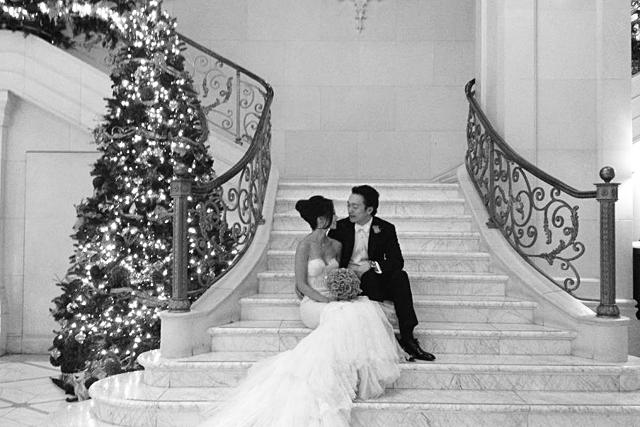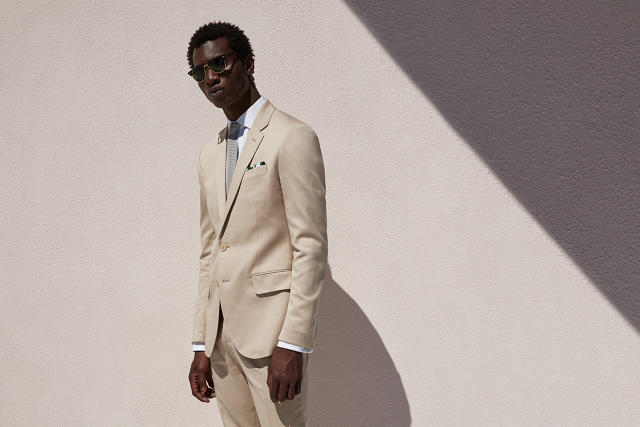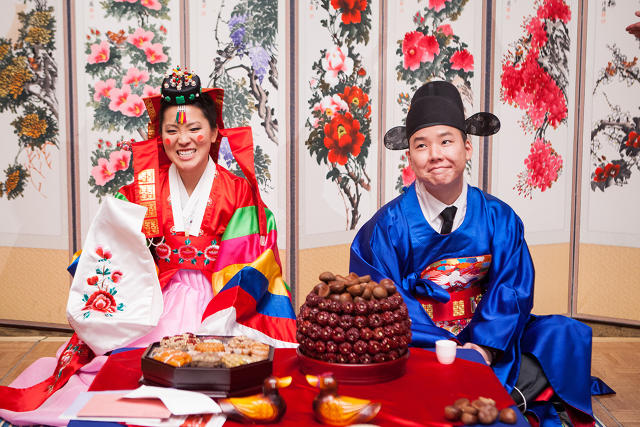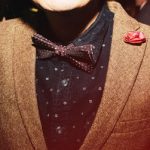Stylish Grooms Say “I Do” To A Second Outfit
Chung Ng knew he wanted to wear something memorable for his wedding at the Plaza Hotel in New York, back in 2012. “They always say it’s the bride’s day, but at the end of the day, it’s both of us getting married and I wanted to make a statement myself,” he says. “The groom can shine a little.”
For the ceremony, he chose a Ralph Lauren Purple Label peak lapel tuxedo, made to measure. “It was a little more classic, a little more regal,” Ng says.

Later, for the cocktail hour and reception, he changed into a Tom Ford tuxedo with a shawl collar. “It would have been too loose for a formal ceremony,” but it was “perfect for dancing.”
Style-conscious grooms like Ng are on the rise. Many use brightly colored details, like pocket squares, to make a statement. Others, taking a cue from the red carpet, wear suits and tuxedos in nontraditional colors or patterns. And at the bleeding edge, a few enterprising grooms are opting for two different outfits, one for the ceremony and one for the reception, as many brides have been doing for years (Ng’s wife wore not just one or two but four dresses).
Andrew Blackmon, cofounder of the tuxedo rental startup the Black Tux, says a growing number of grooms are opting for the double rental. “It’s happening naturally, and we see it happening on a level that surprises us,” he says. “What we see a lot is more formal for the ceremony and less formal for the reception.”
For Black Tux, it’s a potential opportunity. “Some of the styles we’re coming out with later this year, they’ll be for the guy that wants something like that,” he says.

George Zimmer, founder of a rental startup called Generation Tux, says he’s exploring the idea of wedding weekend packages that would include two different looks. “The generation getting married right now wants to do things their own way,” says Zimmer, the long-time face of Men’s Wearhouse (before his unceremonious ouster). “When my generation got married, the brides did about 90% of all the choosing. That’s shifted now.”
Grooms like Porter Allison embody that shift. Allison, a professional DJ who lives in Nashville, describes himself as a “T-shirt and jeans guy.” But for his April wedding to musician Carley Chilton, he coordinated two separate looks, as did the bride: one for the church ceremony in rural Virginia, and the second for the Great Gatsby-themed reception.
“I just wanted to have fun with it,” Allison says. To start, he donned a gray suit and brown shoes, with cufflinks that had been engraved as a wedding gift. “I looked the part of the dapper gentleman.” Then, to embrace the Art Deco aesthetic, he changed into a velvet blazer with dark pants, a black tie, and suspenders. The crowning touch: gold sneakers with LEDs on the sole (his best man wore a matching pair).
“A lot of my groomsmen and some friends wanted to know where they could get a jacket like I had for the second look,” says Allison, who rented from Black Tux. “I really wanted to keep it. I wanted to keep the suit, too.”
Watch an episode of Say Yes to the Dress or scan the weddings on Vogue.com, and it’s not hard to find examples of brides with two wedding dresses (“Later in the evening, Connie changed into a short cocktail dress by Reem Acra so she could move more easily on the dance floor,” reads a typical Vogue post). As wedding budgets (and fashion extravagances) creep upward, it should come as no surprise that grooms are following suit (no pun intended). They are often older than newlyweds of generations past, and confident in their sense of style. Plus, they’re increasingly footing the bill themselves—no small expense in a city like Chicago, for example, where the average wedding cost $61,265 last year. For that amount of money, brides and grooms want their wedding days to reflect who they are and how they like to have fun.
“Guys are really into these more fashion-forward items,” says Blackmon, who in Black Tux’s early days had trouble keeping a navy tuxedo in stock, to the team’s surprise. “The things pushing the fashion spectrum are selling out. What our team notices is that on a macro level, guys are more interested in self-expression through style.”
In an interview with Racked, fashion insider Brian Trunzo said, “The average guy looks better than five or 10 years ago. As a result, he’s going to experiment more.”
Fashion certainly plays a role in the trend toward doubling up on groom attire, but culture may be a factor as well, as couples seek to design celebrations that embrace the heritages of both their families. Four in 10 weddings in the U.S. are now interfaith, double the percentage from 50 years ago. At approximately one in 10 weddings, the newlyweds are of different races. And the children of Asian immigrants, who started arriving in larger numbers in the 1980s, are starting to tie the knot, introducing their friends to wedding traditions from China, India, and Korea.
For their 2014 wedding, Dan Na and his wife Eunice decided to combine American and Korean traditions. First, they had what Na describes as a “conventional American” religious ceremony at a Korean-American church. “We walked down the aisle, we did the candle thing, we exchanged vows,” says the groom, who wore a charcoal suit, white shirt, and black tie. At the reception that followed, they entered as husband and wife to DJ Snake and Lil John’s “Turn Down for What.”

Then, outfit number two for each: pointed clogs and a royal blue floor-length robe called a hanbok, tied at the waist with a gold-embroidered red belt. The couple rented the traditional dress and hired a narrator, who guided them and their guests through the pyebaek (or paebaek) ceremony.
“It was really wild, but it was really cool,” Na says. “I gave [Eunice] a piggyback ride around a table, then my parents threw chestnuts, and she had to catch them in her dress.”
Afterward they took off their robes and cut the cake.
Despite the growing interest, head-to-toe groom outfit swaps remain relatively rare. Wedding blogs report that grooms are indeed changing up their looks after the formal portraits are complete, but often on the margins. “Once the vows have been said, we’ve seen grooms opt for a more playful tie or pocket square, or swap their dress shoes for a pair of Converse,” says Stephanie Weers, managing editor of Style Me Pretty. “It’s all about those subtle ways to infuse a groom’s personal style without detracting attention from his beautiful bride.”
Whether LED sneakers meet that requirement is between you and your future spouse.
Fast Company , Read Full Story
(26)






